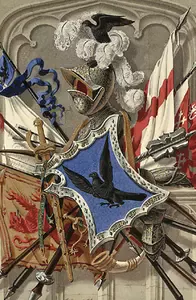- Home
- >
Saturn
[+ links to: A Saturnian Renaissance - The Door to Saturn - Enceladus Erupts - Feeling Naked on Titan Response - Hyperion - Mimas - Prisoners of Saturn - Rescue on Dione - The Rings of Saturn - Titan - What to see on Dione - What to see on Enceladus - What to see on Iapetus -
What to see on Mimas - What to see on Phoebe - What to see on Rhea - What to see on Saturn - What to see on Tethys - What to see on Titan ]
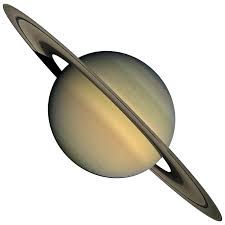
Saturn - what a venue for sagas of the Old Solar System.
Or rather - what a venue it ought to have been.
Picture it - the ringed planet, the beckoning mystery, ready for the taking: a beautiful world almost as immense as Jupiter, and (being much lighter) without Jupiter's gravity problem. And to cap it all, a planet-sized moon, Titan.
Then ask yourself: what's been done with all this?
Answer: not nearly enough!
Except in painting, that is!
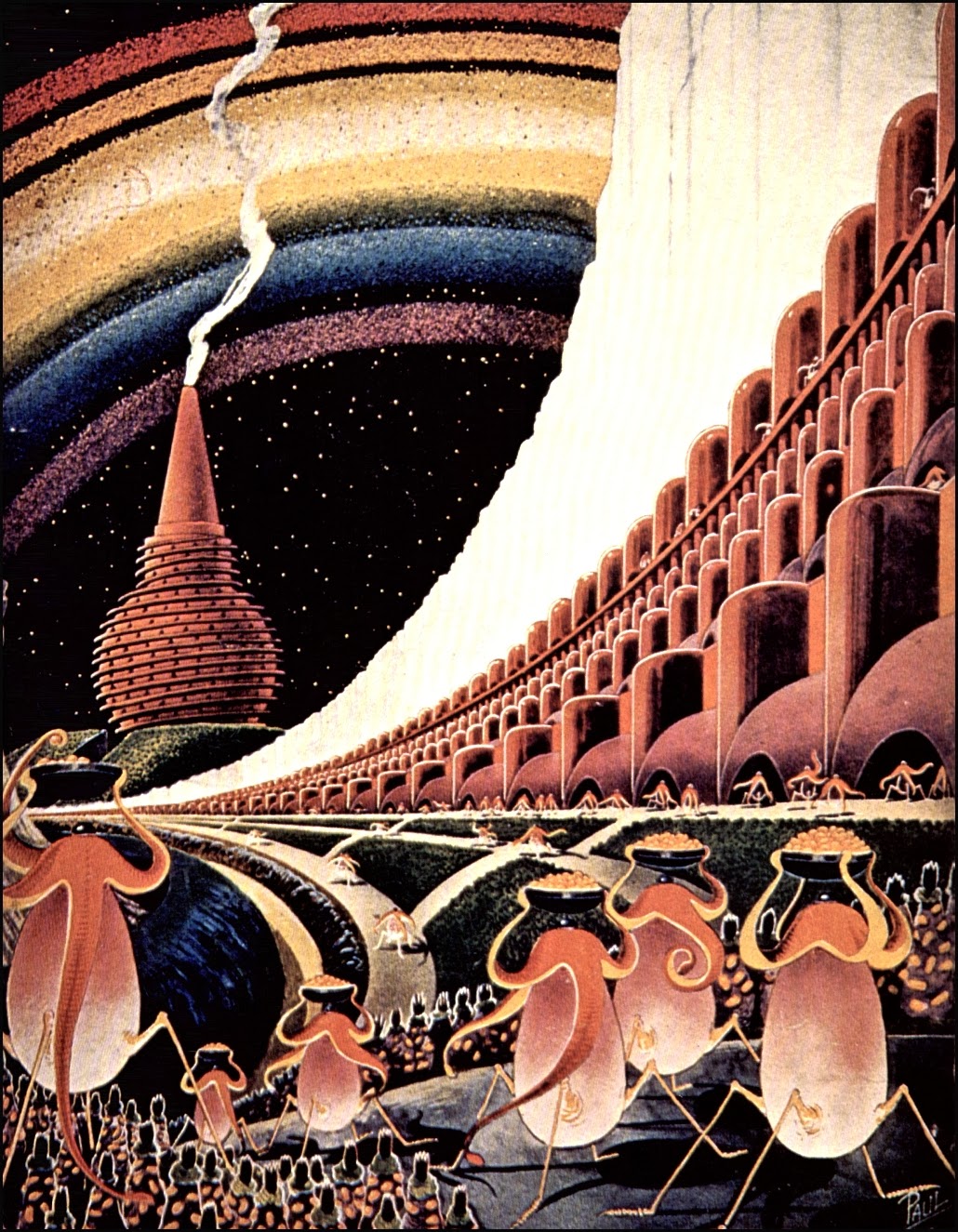 City on Saturn by Frank R Paul
City on Saturn by Frank R PaulAs so often happens, I find myself wishing that Paul could have written stories to go with his pictures. Unfortunately, nothing of the kind has been achieved by the Bards of the Old Solar System...
Harlei: But hang on, I've got here some -
Stid: Don't interrupt Zendexor when he's getting up a head of steam. I sense a big grumble coming on.
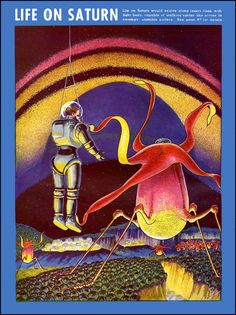 by Frank R Paul
by Frank R Paulthe demand
Zendexor: A wistful grumble. Compare literature and painting: you wouldn't expect an artistic movement to ignore one of the primary colours, would you? Of course not; what a daft omission that would be!
Well then: neither should the genre of planetary adventure have ignored Saturn. For each of the OSS worlds has its own primary strength of being, its unique character or personality.
Stid: Its "quiddity".
Zendexor: Precisely. You've said it the scholastic way. And I say it the oomph way. Each world has its own oomph. Its own, individual, unique up-welling spring of enchantment and allure.
So why not make the most of it?
Harlei: But here's -
Stid: Authors are such Q.A.D.s, aren't they? Quiddity-Appreciation Deficient... in other words, they don't write what you want them to write.
Zendexor: Be as dry as you like, Stid - at least you're not contradicting me.
Harlei: Hold it, both of you - will you listen? I keep trying to tell you, things aren't as bad as all that. Look, I have some Saturnian narrative here, some proper OSS Saturn-with-a-solid surface narrative.
Zendexor: Scraps do exist, I know. Go on, Harlei, show us what you've got.
Harlei: Right then - here's a view of a landscape.
captain future's saturn
...Presently they were rushing over the sunlit, tumbled valleys and scrubby forests of the equatorial regions. The plant life was of all shades of blue and purple.
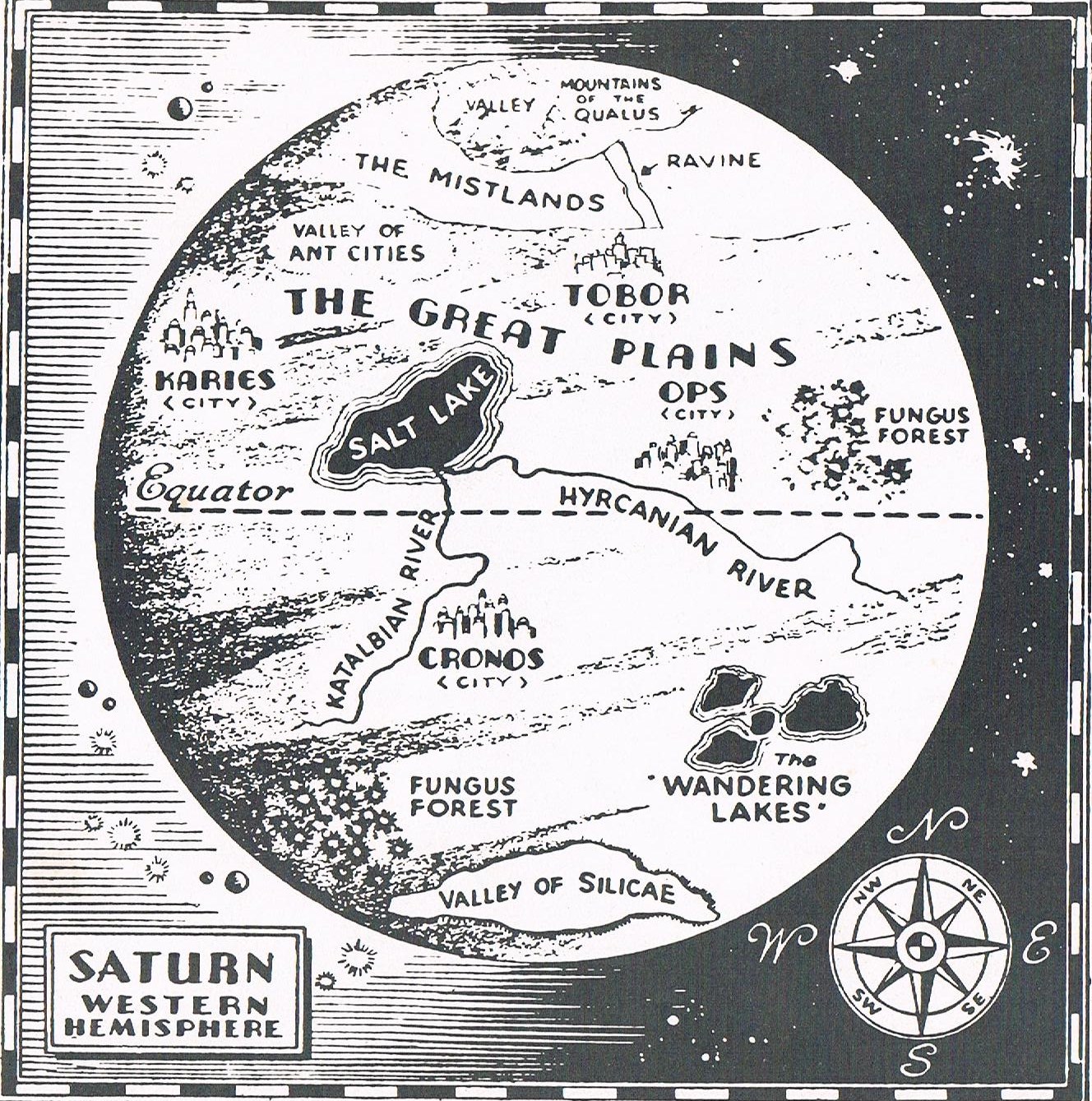
The city Ops came into sight ahead - a sprawling black dot on the blue plain. It lay in the oblique rays of the little Sun setting at the western horizon. The great Saturnian metropolis would never lose its archaic look. It had been old long before the first Earthmen came pioneering through space to open up interplanetary commerce.
Ops covered nearly forty square miles of the blue plain. A vast mass of flat-roofed buildings of black cement, it was cut by crooked, narrow, old streets. Its central section rose to big, square, black structures of many stories. The black Hyrcanian River wound lazily through the city like an ebon snake, beneath many massive bridges.
Zendexor: I would be getting excited, except that I recognize where this is from. Galaxy Mission, yes? Yes.
Harlei: A ludicrous name for a book of which the action all takes place in the Solar System. Should have been titled "Saturnian Mission". But it's not a bad book.
Zendexor: I agree, it's not bad at all. All the Captain Future adventures are good enough when one's in the mood to read like a young teenager. But they're very thin when it comes to a sense of place. You have to provide most of the atmospherics yourself. But as I'm so sorely lacking any news from Saturn, go ahead and see what else you can squeeze out of the book.
Harlei: All right, here's where Captain F. sets out from Ops, the capital, to drive eastwards by "rocket-car":
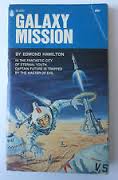
Curt swung past the spaceport. Soon he was out of the great Saturnian city and heading eastward over the rolling farm-fields. The Sun had now risen, a small, brilliant disk. The Rings were a pale white arc across the high southern heavens.
Quickly Captain Future left behind him the broad cultivated fields and pastures that surrounded the city. Before him stretched the blue, grassy plain, undulating away to the far horizon. Here and there the treeless flatlands dipped into valleys. The only vegetation were low black shrubs with purplish blooms...
...An hour after leaving Ops, Curt Newton's car crested the rim of a deep, broad valley that stretched away for many miles.
Down in this valley, filling it from rim to rim, sprawled a choked forest of fantastic, mushroomlike yellow growths. They made the valley stand out like a bright yellow blot on the rolling blue plain.
Zendexor: Thanks. It's better than nothing, but you'll agree, I think, that it's very simple stuff.
Harlei: The book gives us a few more aspects to Saturn. Some of the fauna, in the Ops zoo. The northern Mistlands and the winged Qualus.
Unfortunately - I know you won't like this, Zendexor - Captain Future concludes that the Qualus were descended from ordinary wingless Saturnian humans.
Zendexor: I feared as much. The COMOLD again - the "common-origin let-down". For my sinking feeling is, that not only are the Qualus related to the Saturnian humans, but also the latter share a common origin with us. All this comes out, I seem to recall, when Captain Future eventually explores interstellar space and finds, somewhere around Deneb, evidence for a past star-faring race who seeded all the worlds with humans - what a bore.
Enough of Captain Future.
Now for something completely different! Time to consider an infinitely more Saturnian Saturn-book.
be very excited - though there's a "but"
Harlei: I thought you said there weren't any. I thought that was what you were complaining about.
Zendexor: You'll get the picture when I give you the bad news about this next yarn. But first, the good news about it.
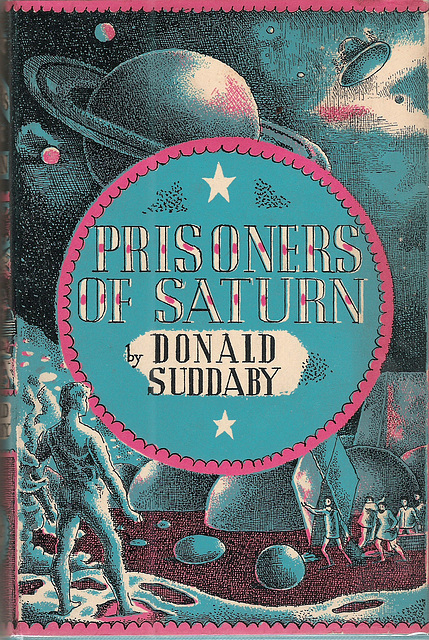
Prisoners of Saturn is so evocative, in its portrayal of that world, that it sends shivers up my spine and recalls me to my childhood -
Stid: Which is never far away.
Zendexor: Suppose your dig is right and I am childlike, it's still worth asking: what kind of book can tap that source so well? Tap into something profound, and draw it out as an unforgettable image... In this case, the image of the Saturnian sentient clouds, who sculpt their world into geometric landscapes.
You may well ask, how is contact established with such beings? Answer: the clouds shape part of themselves into a semi-solid or solid humanoid shape, for the purpose of speaking to the travellers from Earth.
Now, after many years of wanting my own copy, I've recently acquired the book, and shall be doing a page on it, and displaying some of the great illustrations by Edward Ardizzone which form an integral part of it. But for you unfortunates who would also like a copy, here I must mention one grave defect of Prisoners of Saturn:
UNOBTAINABILITY!!!
Unless you have access to the British Library, the Bodleian, the Cambridge University Library or the Library of Congress, you may have trouble getting hold of Donald Suddaby's masterpiece.
Also, there's another criticism I could make, though I may be in a minority in thinking that it matters:
Although the Saturnian settings are brilliant, and the landscape and the creatures and the culture are wonderfully interesting, the most advanced "Saturnian" race turns out to be not strictly Saturnian in origin. They did evolve in the Saturn system, but on the large moon Titan, not on the giant planet itself. Long ages ago in the past they descended from the moon to colonize the planet. By means of their vast powers they altered Saturn's gravity, its level of illumination and the composition of its lower atmosphere to suit themselves. The Rings turn out to be artificial, part of this huge process...
Stid: So as far as real Saturnian Saturnians are concerned, have you shot your last Saturnian bolt, then, Zendexor?
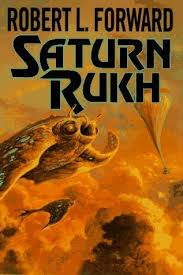
Zendexor: As far as novels are concerned, yes. All right, there's Saturn Rukh, but that's modern stuff, realistic, nothing OSS about it.
(The "Rukh" means "roc", as in the giant bird in Sinbad the Sailor. The giant creatures that live in Saturn's atmosphere conform to Carl Sagan type ideas of what might really be possible on the giant planets.)
By the way, I was never able to finish Saturn Rukh. In my opinion it's not nearly so good as the same author's Dragon's Egg (about life on a neutron star) - but I may have another go at it sometime.
Meanwhile, back to the OSS. And the problem this page suffers from, the dearth of tales set on the sixth planet...
a short visit, with some good aspects
Missing Men of Saturn (1953) is a novel I hadn't heard of until recently...
Stid: That's a bad sign for a start, isn't it?
Zendexor: Well, possibly. But listen, I'm glad I obtained it, glad I read it - and I was able to read it to the end, in a sufficient glow of wonder. First, get a taste of this promising build-up:
...Everyone knew the story of the intrepid Captain Dearborn who had led the first and only expedition to the ringed planet a century before. He had apparently established headquarters on Titan, the largest satellite, and had then attempted to push closer to the planet by establishing temporary bases on Rhea and Dione. But there the record ended. It was as if some giant catastrophe had wiped out the entire crew without a trace. There were rumors of messages from the ill-fated expedition picked up by spaceships cruising beyond Jupiter, but they were only rumors. If such messages indeed existed, the Department of Space Security had for reasons best known to itself never chosen to make them public. Thus through the years a legend had grown up around Saturn as a world to be shunned, an ultima Thule or last outpost, inhabited by ghosts and evil spirits...
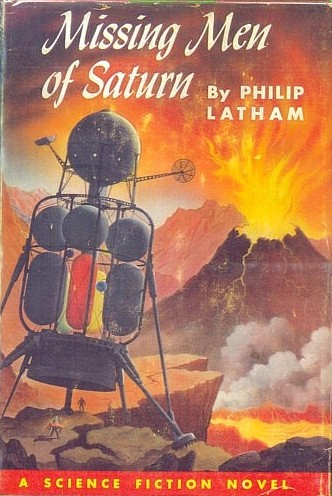
Now, honesty compels me to admit that Latham's Saturn is nothing like as good as Suddaby's. But it's not a pale copy of the greater book; it's worth reading for its own sake. The Saturnians, who are very advanced in some respects and unexpectedly weak in others, are highly adaptable physically:
...In his journey to the council he had seen the creatures frolicking under a pressure of probably a thousand atmospheres, while they were equally at ease under near-vacuum conditions on Titan...
This means that they live unprotected both on Saturn's gloomy surface and in caverns thousands of miles deep. That "journey to the council" is a revelation to the protagonist, Dale Sutton.
...Through the heavy windows in the side of the sphere, Dale saw that he was in a region filled with some substance that was neither liquid nor gaseous, but appeared to possess some of the properties of both. More than anything else he could think of, it reminded him of pea soup, except that it was faintly luminous and partially transparent. Objects at a distance of a hundred feet were fairly distinct, but beyond that they blurred and dimmed like out-of-focus images on a motion-picture screen.
The scenery around him resembled masses of taffy candy that had been twisted and distorted into every form imaginable and then left to cool. Dale suspected that these remarkable forms had been produced by some cataclysm in which hydrogen in a highly turbulent state had suddenly been forced to solidify under enormous pressure. In places the walls were streaked by narrow veins of a silvery substance - probably hydrogen in the metallic state. There were other mineral structures whose nature he could not even guess: giant crystals growing out of the rocks like the petals of a flower and huge stalactites hanging from the cavern roof like glittering icicles.
But the most amazing sight was the inhabitants of the region themselves. The landscape was crawling with them. They swarmed over the cavern walls and over each other. They leaped upon the bathysphere. They pressed their grinning faces against the window...
Dale Sutton incidentally is an extremely well-drawn hero. His conversion from snob to all-right guy is one of the unexpected bonuses of the book.
Unfortunately the "Saturnians" - according to speculation, though this isn't absolutely certain - turn out to have been descended in ages past from colonists from the Tenth Planet, Anteros, so that rather detracts from their authenticity to my way of thinking. Therefore we still haven't found the ultimate honest-to-goodness real thing: that's to say, we still lack a novel that's as much Saturnian as Barsoom is Martian.
But I can point to one remaining bright spot in the generally gloomy picture for Saturn-fans.
clark ashton smith on saturn
The Door to Saturn is only a short story, not a novel, and moreover it's not serious - it is light, fanciful, humorous, whimsical. Nevertheless if you try it you'll find it beautifully and powerfully written, unforgettably vivid and well-imagined.
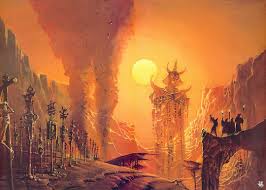
Somewhat of a farce, it nevertheless packs into its nineteen pages more punch than many a novel.
The Bruce Pennington covers for Lost Worlds volumes 1 and 2 are not illustrations for the story, but they do, I think, express some of the mood of The Door to Saturn.
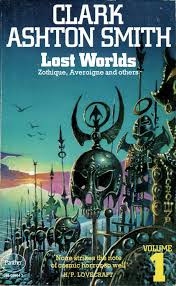
It can hardly be classed as science fiction, or even science fantasy, and yet, from the moment the sorcerer Eibon escapes his enemies by going through the transdimensional Door, the story runs no longer on literal magic but on the figurative magic of wonder, of colour and adventure, giving us a Saturn with Saturn-ness, that's to say a possible OSS Saturn in a science-fictional spirit.
...He was standing on a long declivity of ashen soil, down which a sluggish stream that was not water, but some liquescent metal resembling mercury, ran from tremendous unscalable shoulders and horns of the mountain heights above, to debouch in a hill-surrounded lake of the same liquid.
The slope beneath him was lined with rows of peculiar objects; and he could not make up his mind whether they were trees, mineral forms, or animal organisms, since they appeared to combine certain characteristics of all these. This preternatural landscape was appallingly distinct in every detail, under a greenish-black sky that was over-arched from end to end with a triple cyclopean ring of dazzling luminosity. The air was cold, and Eibon did not care for its sulphurescent odor or the odd puckery sensation it left in his nostrils and lungs. And when he took a few steps on the unattractive-looking soil, he found that it had the disconcerting friability of ashes that have dried once more after being wetted with rain.
After a while it turns out that Eibon's enemy the high-priest Morghi has followed him through the Door. Morghi greets Eibon with the words,
"Detestable sorcerer! Abominable heretic! I arrest you!"
- but Eibon swiftly points out that there's no point in quarreling now that they are both stuck on an alien world; and the story then comically relates how the two former enemies strike up a grudging alliance.
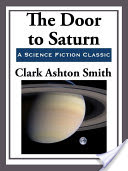 Happily, this edition calls it science fiction.
Happily, this edition calls it science fiction.After a narrow escape from the "simple and patriotic Bhlemphroims", who consider it an honour to be eaten by their "national mother", the two wizards wander on
...among more than one of those unusual races who diversify so widely the population of Saturn. They saw the Djhibbis, that apterous and Stylitean bird-people who roost on their individual dolomites for years at a time and meditate upon the cosmos, uttering to each other at long intervals the mystic syllables yop, yeep and yoop, which are said to express an unfathomed range of esoteric thought.
And they met those flibbertigibbet pygmies, the Ephiqhs, who hollow out their homes in the trunks of certain large fungi, and are always having to hunt out new habitations because the old ones crumble into powder in a few days. And they heard the underground croaking of that mysterious people, the Ghlonghs, who dread not only the sunlight but also the ring-light, and who have never yet been seen by any of the surface-dwellers.
It's certainly a humorous tale rather than a straight adventure, and yet its vividness is salted with menace, especially during the episode of the Bhlemphroims. A classic.
If your home library happens to lack the works of Clark Ashton Smith (in other words, if you lack the bare essentials of life) you can read them online in the superb website www.eldritchdark.com.
murk with possibilities
Harlei: You ought not to finish yet. Here's another story to consider: Trouble on Titan - which despite its title contains quite a long scene set on Saturn itself.
Zendexor: Yes, I know, the visit to Titan was an emergency landing on the way back from the visit to Saturn. All right, let's consider this story, which appeared in 1941, the same period that Captain Future was rampaging through the magazines.
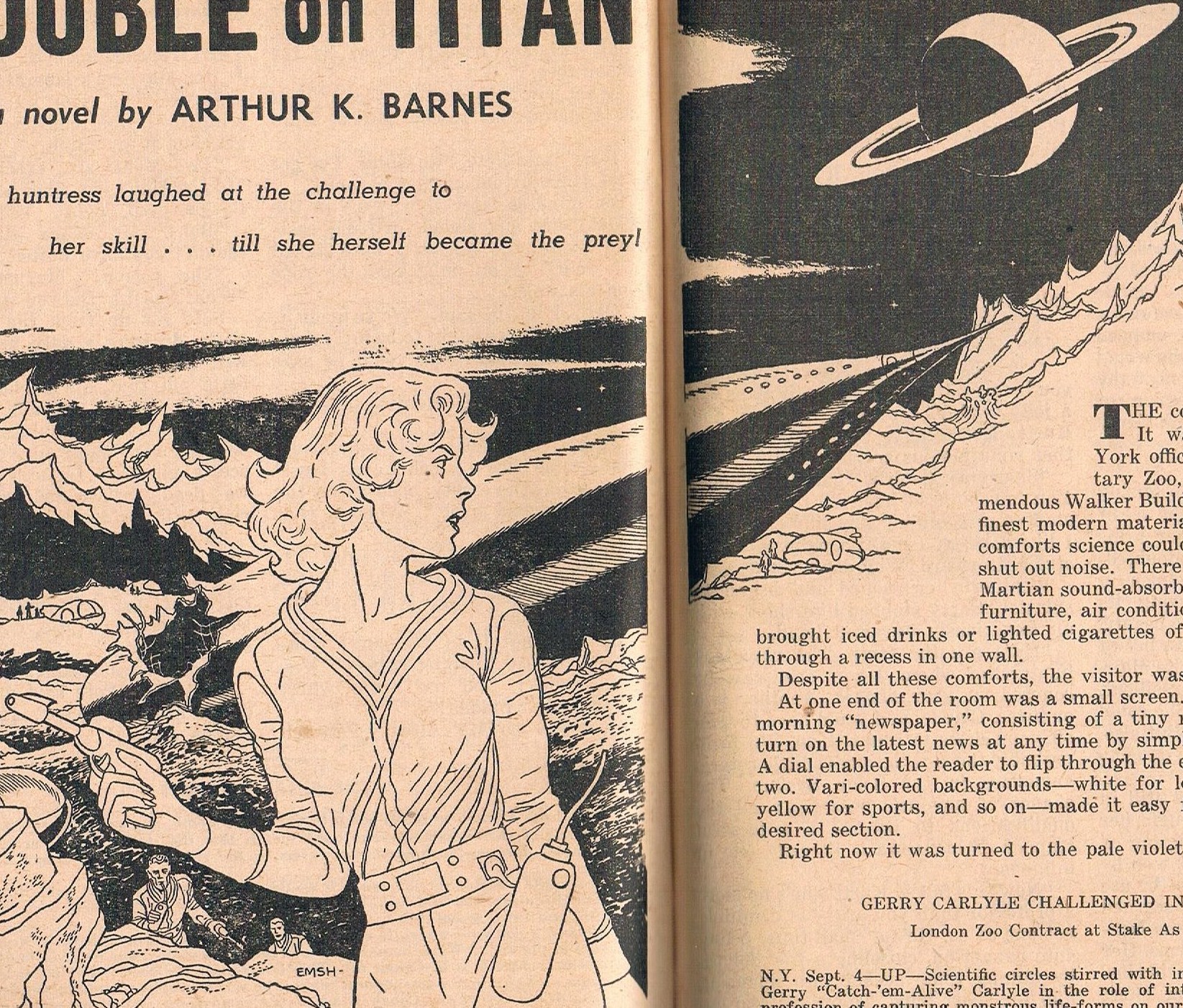
Rampaging likewise, the characters in Trouble on Titan - the trapper Gerry Carlyle, accompanied by her husband Tommy Strike - are in the habit of zooming around the Solar System in Gerry's ship the Ark in order to capture alien beasts for zoos on Earth. This time the lady aims to catch a Saturnian creature called a dermaphos.
This pair of go-getters aren't the sort to reflect on the wonders of the universe, but never mind - the big question is, can we hope that the tale gives us a habitable Saturn with a solid surface?
Answer: Yes - it does! Only, it's rather dim and gloomy:
The Inferno, as described by Dante, is an unpleasant place. But for sheer ugliness, inhospitality, and danger, it fails to approach the planet Saturn. Twenty-one days in that dreary hell convinced Tommy Strike of Saturn's absolute hideousness.
There was one favorable aspect. The surface gravity of Saturn was not much different from that of Earth. All other aspects concerning that malodorous world afforded nothing but peril and discomfort to human beings. Of this Strike was positive, as he gazed over the bleak landscape.
[Now of course we OSS fans are happy enough to be able to gaze over a landscape at all, on something as exciting as a solid-surface Saturn. So we tolerate Tommy Strike's negative attitude and continue hopefully to look through his eyes.]
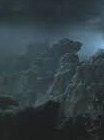
The surface of Saturn was rugged. Tremendous mountain ranges reared massively into the murky atmosphere, colossal on a scale that would dwarf anything known on Earth.
[Hang on, if it's that murky, how come you can see such colossal ranges? Never mind - press on. A meal of scraps is better than an empty plate. Let's read on about the Saturnian mountains.]
Most of their surfaces were frozen solid. That was not so much because of temperature - for internal heat had made Saturn sufficiently warm to support life -
[Horray! A solid surface with visibility and life!]
- but because of the great pressures created by Saturn's thousands of miles of atmosphere.
[Uh? Are we being that realistic?]
Stid: I see why you're having trouble with this story. It seems to try to do two incompatible things: give us a gas giant Saturn and a visible-habitable-solid-surface Saturn, at one and the same time.
Not that the tale makes scientific sense anyway, even in its gas-giant aspect alone: for the author is telling us that the "frozen solid" goes with the "great pressures", whereas in fact pressure is more likely to liquefy... or so I would have thought.
Zendexor: Press on, press on. We're going to find some nuggets of meaning, some nice ideas and images amid this incoherence - if we're patient. Just try to accept, for now, that on this Saturn the pressure has a freezing effect.
This was proved by the occasional outcroppings of blue-gray "rock", which were solidified ammonia.
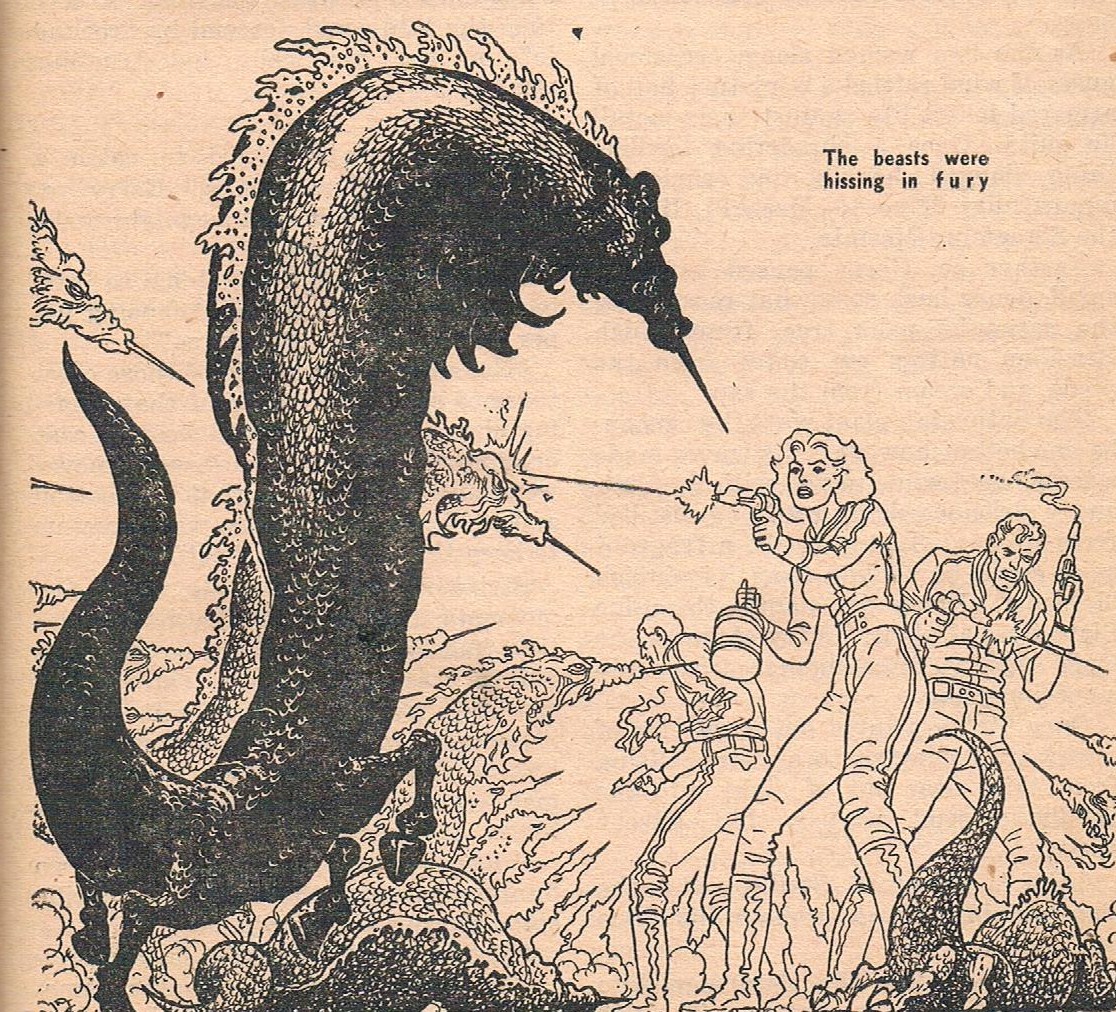 Gerrry trying to anaesthetise a Saturnian dermaphos
Gerrry trying to anaesthetise a Saturnian dermaphos[Next, you're going to have to believe that one can stroll among outcrops of solidified ammonia, because Tommy Strike is reluctantly persuaded, by his wife the leader of the expedition, to go out for a walk with her on Saturn.
To add to the confusion, the magazine illustration makes it look as though they're dressed as if for an outing on Earth - though the text does say they don spacesuits.]
Strike made a wry face, but obediently turned to the empty suit standing within the air-lock. A moment later, properly dressed, he stepped with Gerry to the hard-packed soil of Saturn's lowlands. The hour was midday, though full daylight was only a weak solution of night.
Gerry squinted a weather eye at the heavens, observed the turgidly boiling fragments of cloud masses whipping past. The daily windstorm, which came regularly enough to set a clock by, was about over. Now its tag ends were confined to the upper reaches. Common to all the larger planets, Saturn suffered tremendous gales of ammonia and methane that raged above the main body of hydrogen-helium atmosphere.
Stid: I know you think I quibble too much, Zendexor, but actually I'd applaud the perfunctory style of excuses employed by Edgar Rice Burroughs, for instance. I mean, his explanations are thin, but they are at least some tribute-payment to the common sense of the reader. For instance on his version of Jupiter we're able to see things underneath the cloud envelope because the landscape is lit by volcanoes. It's a kind of courtesy to the reader, that he bothers to invent that reason. Or you could plump for phosphorescence, or bioluminescent fungi, or the explorers might wear infrared goggles, whatever... any excuse is better than none at all. But this author leaves us in the lurch: he talks about "thousands of mile of atmosphere" and leaves us at the bottom of it, on our own as it were, to invent our own reasons why we're still able to see...
Zendexor: Patience, Stid, we're almost there. Almost at the hidden treasure which makes the time we've spent on this story worth while. Two more paragraphs - and watch for the second one. The theme you'll find is as good as gold, and though it's hardly at all developed in this story, it's just waiting to be taken up by other writers of OSS style tales set on the giant planets!
Here goes:
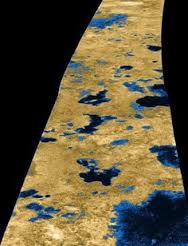
The Ark was resting in the bottom of a moderate-sized valley. This landing place had been chosen partly because it afforded shelter against the elements, but mostly because of a remarkable feature of Saturn's atmosphere.
There were still traces of oxygen on the planet. Being heavier than the other gases on the planet, the oxygen had gathered in "pools" in the low spots. Since animal life was dependent upon oxygen even on that miserable planet, the results was that small "islands" of life were distributed over Saturn, existing only where sufficient oxygen remained. Naturally, that helped Gerry's search considerably. The Ark simply hopped from valley to valley till they found a spot with one or more speciments of the dermaphos they were seeking.
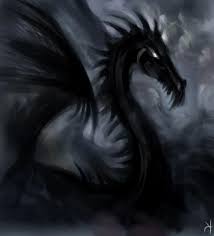 Saturnian Mist-Lurker?
Saturnian Mist-Lurker?That's it; I won't go on quoting from this mostly-disappointing tale. You've just seen what a marvellous notion it tosses off: how terrific the potential of the idea of these "islands" of life in the isolated "pools" of oxygen on the so-called "miserable planet" which, in the hands and mind of a greater author, could have become a scene for an epic scintillating with colour, fascination and grandeur! Hint, hint - get going, you retro authors.
Arthur K Barnes, "Trouble on Titan" (Thrilling Wonder Stories, February 1941); Robert L Forward, Dragon's Egg (1980); Saturn Rukh (1997); Edmond Hamilton, Galaxy Mission (1940); Philip Latham, Missing Men of Saturn (1953); Clark Ashton Smith, "The Door to Saturn" (Strange Tales, January 1932; included in Lost Worlds (1944; reprinted as a two-volume paperback 1974)); Donald Suddaby, Prisoners of Saturn (1957)
For a first delighted reaction to Philip Latham's Missing Men of Saturn, see the Diary for
8th October 2016.
Re an early Edmond Hamilton tale of an invasion from Saturn, click here.
For nineteenth-century speculations about life on Saturn, see the OSS Diary for 21st November 2016.
For the passage in Niven and Pournelle's Footfall expressing a temporary flicker of suspicion that an invasion might be coming from Saturn, see the OSS Diary for 8th April 2017.
See Enceladus and Europa - the last OSS worlds? for comments about possible life on Enceladus.
For some vivid lines of poetry by Clark Ashton Smith on a Saturnian king, see the Diary for 5th November 2018.
For Evelyn E Smith's The Vilbar Party see Saturnian Teddy-Bears.
For conforming or failing to conform to an archetype see Astrology and a warm Saturn.
For the lack of tales set on Hyperion see The unchronicled world.







